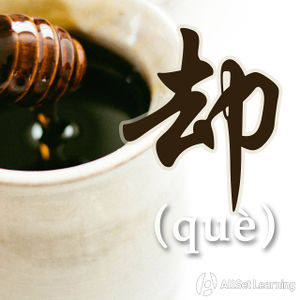Difference between revisions of "The "however" adverb "que""
| Line 3: | Line 3: | ||
==Structure== | ==Structure== | ||
| + | |||
| + | The overall structure of sentences that use 却 is something like this: | ||
| + | |||
| + | <div class="jiegou"> | ||
| + | [Clause 1, which makes a statement], [Clause 2, which uses 却 and includes a negative comment] | ||
| + | </div> | ||
| + | |||
| + | To make clearer how 却 fits into the second clause: | ||
<div class="jiegou"> | <div class="jiegou"> | ||
| Line 9: | Line 17: | ||
It's also important to point out that 却 is not a [[conjunction]]; it's an [[adverb]]. Practically speaking, this means that rather than joining two statements, it goes ''inside'' a statement (within the second clause). Specifically, it needs to come ''after the subject'' and ''before the verb''. (Note that when you use a conjunction like 但是 it comes ''before'' the subject! 却 is different in this respect. Also, rather than ''replacing'' 但是, it can work with it to add emphasis. | It's also important to point out that 却 is not a [[conjunction]]; it's an [[adverb]]. Practically speaking, this means that rather than joining two statements, it goes ''inside'' a statement (within the second clause). Specifically, it needs to come ''after the subject'' and ''before the verb''. (Note that when you use a conjunction like 但是 it comes ''before'' the subject! 却 is different in this respect. Also, rather than ''replacing'' 但是, it can work with it to add emphasis. | ||
| + | |||
| + | Also, sometimes the subject of the second clause will be omitted. If there is a subject, however, 却 definitely need to come ''after'' it. | ||
<div class="liju"> | <div class="liju"> | ||
Revision as of 03:14, 3 July 2012
却 (què) is used to indicate something was contrary to expectations, and is used in a similar way to 倒. However, it is generally followed by a negative comment:
Structure
The overall structure of sentences that use 却 is something like this:
[Clause 1, which makes a statement], [Clause 2, which uses 却 and includes a negative comment]
To make clearer how 却 fits into the second clause:
[Clause 1], Subject + 却 + negative comment
It's also important to point out that 却 is not a conjunction; it's an adverb. Practically speaking, this means that rather than joining two statements, it goes inside a statement (within the second clause). Specifically, it needs to come after the subject and before the verb. (Note that when you use a conjunction like 但是 it comes before the subject! 却 is different in this respect. Also, rather than replacing 但是, it can work with it to add emphasis.
Also, sometimes the subject of the second clause will be omitted. If there is a subject, however, 却 definitely need to come after it.
- 我 等 了 她 很 长 时间 ,却 她 没 来 。
- 我 等 了 她 很 长 时间 ,她 却 没 来 。
- 有 些 人 的 博客 的 文章 不 多 , 却 内容 不 错 。
- 有 些 人 的 博客 的 文章 不 多 , 但是 内容 却 不 错 。
- 有 些 人 的 博客 的 文章 不 多 , 内容 却 不 错 。
- 有 些 人 的 博客 的 文章 不 多 , 但是 内容 不 错 。
Examples
In the following examples, take note that 反而 comes after the subject in each case, and that it can be used together with 但是.
- 他 用 的 潜水 装备 都 很 专业,但是 他 的 水平 却 很 低。
- 虽然 是 自己 种 的 菜,不过 味道 却 没有 超市 的 好。
- 他 只有 16 岁,想法 却 比 20 几 岁 的 人 还 成熟。



